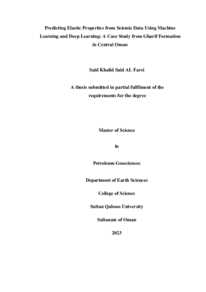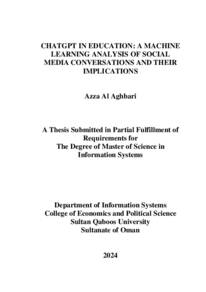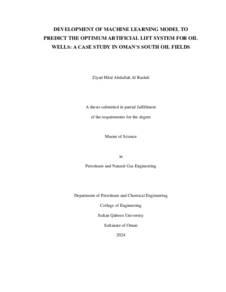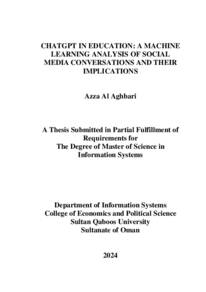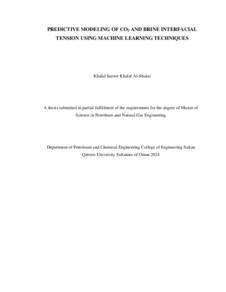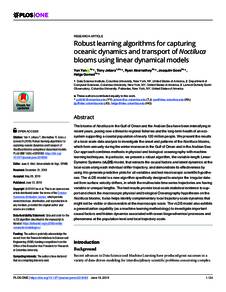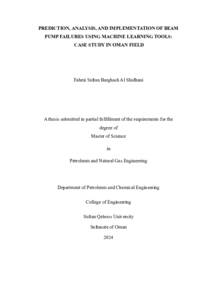Document
Predicting elastic properties from seismic data using machine learning and deep learning : a case study from Gharif formation in central Oman.
Source
Master's thesis
Other titles
توقع الخصائص المرنة من الموجات الزلزالية باستخدام تعلم الآلة والتعلم العميق : التطبيق على تكوين الغريف من وسط عمان
Country
Oman
City
Muscat
Publisher
Sultan Qaboos University
Gregorian
2023
Language
English
Thesis Type
Master's thesis
English abstract
During the exploration phase, understanding the reservoir is a demanding task due
to geological complexities and limited data availability. Advanced techniques are
used by geoscientists to interpret available data, such as well logs and seismic data,
for gaining insights about porosity, permeability, lithology, and hydrocarbon
saturation of the reservoir. Seismic inversion is one of these key techniques that
coverts seismic data into elastic properties like P-impedance and S-impedance.
This technique performs excellently given the seismic data is high-quality and
minimally corrupted by noise and multiples. However, its efficiency deteriorates
with poor quality seismic data. Machine Learning serves as a viable alternative in
these situations, offering the potential to transform seismic data into elastic and
physical properties, showing satisfactory results and performance in many
instances.
The Gharif Formation is a significant oil and gas reservoir producer in Oman,
primarily comprising sand and shale with a carbonate layer easily identifiable in
seismic data. However, differentiating between sand and shale layers within the
Gharif Formation proves difficult due to its depth and low seismic resolution
within its range. Furthermore, distinct differences in physical and elastic
properties make it especially challenging to visualize channel extensions and
segregate sand from shale in the Gharif Formation.
This project aims to leverage Machine Learning and Deep Learning capabilities
to convert seismic data into elastic properties, P-impedance, S-impedance, and
Vp/Vs, facilitating the differentiation of sand from shale in the Gharif Formation.
Several algorithms were tested to achieve optimal results, including eight key
algorithms: shallow algorithms like Linear Regression, Ridge Regression, Lasso
Regression, Support Vector Machine Regressor, Rain Forest Regressor and Multilayer Perceptron, and Deep algorithms such as Convolutional Neural Networks
and Deep Neural Networks.
The study was divided into three stages. The first stage involved using various
algorithms to transform synthetic seismic data generated from wells into Pimpedance. The shallow algorithms' results weren't as effective as expected,
achieving a correlation of about 70%. Conversely, the deep algorithms
demonstrated excellent results, with DNN, CNN, and the shallow algorithm MLP
achieving 89.65%, 89.09%, and 76.05% of accuracy respectively. In the second
stage, MLP, DNN, and CNN algorithms were compared regarding their
performance in predicting P-impedance from actual 3D full-stack seismic data,
with MLP outperforming the rest. The project's final stage involved using substacks of seismic data (near, near-mid, mid and far) to predict P-impedance, Simpedance, and velocity ratio. The AI-based inversion results were validated using
seven blind wells, showing a similar performance to the science-based AVO
inversion. Subsequently, the AI-based inversion outputs were used to calculate
sand and shale probabilities using the rock fluid index (RFI). The probability cube
enabled the extraction of several maps below the upper Gharif horizon to highlight
the channels.
Arabic abstract
خلال مرحلة التنقيب، يُعتبر فهم الخزان مهمة صعبة في قطاع النفط والغاز بسبب التعقيدات الجيولوجية وقلة توفر البيانات. يستخدم علماء الجيولوجيا تقنيات متقدمة لتفسير البيانات المتاحة، مثل سجلات الابار والبيانات الزلزالية، للحصول على فهم واضح حول النفاذية، والمسامية، ونوعية الصخور، وتشبع الهيدروكربون في الخزان. تقنية الانعكاس الزلزالي هي واحدة من هذه التقنيات الرئيسية التي تحول البيانات الزلزالية إلى الخصائص المرنة للصخور. هذه التقنية تعمل بشكل ممتاز إذا كانت البيانات الزلزالية ذات جودة عالية وملوثة بشكل ضئيل بالضوضاء. للتطبيق في ومع ذلك، فإن كفاءتها تتدهور مع سوء نوعية البيانات الزلزالية. يعتبر التعلم الالي بديالً قابالً هذه الحالات، حيث يقدم القدرة على تحويل البيانات الزلزالية إلى الخصائص المرنة والفيزيائية للصخور، ويظهر نتائج وأداء مرضي في العديد من الحالات. يعتبر تكوين غريف خزان منتج رئيسي في سلطنة عمان، يتألف في الاساس من الرمل والطين مع طبقة من الصخر الجيري الذي يمكن التعرف عليه بسهولة في البيانات الزلزالية. ومع ذلك، فإن التمييز بين طبقات الرمل والطين داخل تكوين غريف تزداد صعوبته بسبب العمق والدقة الزلزالية المنخفضة ضمن نطاق التكوين. علاوة على ذلك، فإن الاختلافات الواضحة في الخصائص الفيزيائية والمرنة تجعلها صعبة بشكل خاص عند محاولة فهم شكل القنوات المائية وفصل الرمل عن الطين في تكوين غريف . هدف هذا المشروع هو الاستفادة من قدرات التعلم الالي والتعلم العميق لتحويل البيانات الزلزالية إلى خصائص مرنة، مما ييسر التمييز بين الرمل والطين في تكوين غريف. تم اختبار العديد من الخوارزميات لتحقيق النتائج المثلى، بما في ذلك ثماني خوارزميات رئيسية: خوارزميات ضحلة مثل الانحدار الخطي، انحدار الحافة، انحدار الليسو، آلة الدعم الفيكتوري وغابة المطر، خوارزمية متوسطة مثل النواة المتعددة الطبقات، وخوارزميات عميقة مثل الشبكات العصبية الالمتناهية والشبكات العصبية العميقة. تم تقسيم الدراسة إلى ثالث مراحل. تتضمن المرحلة الاولى استخدام العديد من الخوارزميات لتحويل البيانات الزلزالية الاصطناعية الت ي تم إنشاؤها من الابار إلى المق ا ومة الصوتية الرئيسية. لم تكن نتائج الخوارزميات الضحلة فعالة كما كان متوقعا نج ا حا بنسبة حوالي .٪70على الجانب الاخر، أظهرت ،ً حيث حققت 12 الخوارزميات المتوسطة والعميقة نتائج ممتازة، حيث حققت DNNو CNNوMLP نسبة ،٪89.65 و،٪89.09 و٪76.05 على التوالي. في المرحلة الثانية، تمت مقارنة خوارزميا ت MLPو DNNو CNNفيما يتعلق بأدائها في التنبؤ بالمقاومة الصوتية الرئيسية من البيانات الزلزالية الحقيقية ثلاثية الابعاد، حيث كان أداء MLP هو الافضل بالمقارنة مع البقية. وكانت المرحلة النهائية لهذا المشروع تتضمن استخدام stacks-sub من البيانات الزلزالية )قريب، قريب-متوسط، متوسط وبعيد( للتنبؤ بالمقاومة الصوتية الرئيسية وبالمقاومة الصوتية الثانوية، ونسبة السرعة. تم التحقق من صحة نتائج الانعكاس القائم على الذكاء الاصطناعي باستخدام سبعة آبار عمياء، وأظهرت أدا ًء مماثالً الزلزالي القائم على المعادالت الرياضية .فيما بعد، تم استخدام نتائج الانعكاس القائم على الذكاء الاصطناعي لحساب احتمالية وجود الرمل والطين باستخدام مؤشر السائل الصخري .(RFI (سمحت نتائج الاحتمال باستخراج العديد من الخرائط التي بدورها توضح تمدد القنوات المائية في تكوين غريف.
Category
Theses and Dissertations

